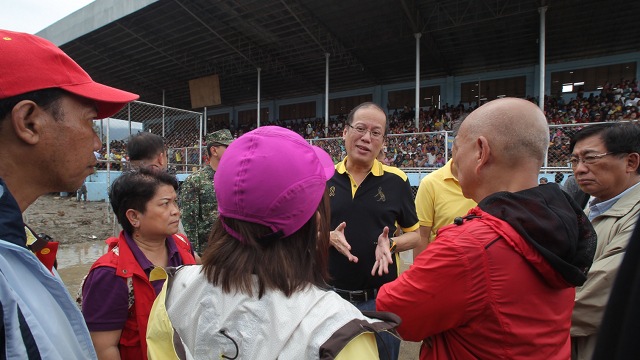SUMMARY
This is AI generated summarization, which may have errors. For context, always refer to the full article.

MANILA, Philippines – Even from the eyes of the President, the aftermath was like a war zone.
President Benigno Aquino III graphically described the destruction he saw with his own eyes as he visited the areas Typhoon “Pablo” (Bopha) walloped in Mindanao.
Aquino flew to the sites on Friday, December 7, with his Cabinet. He told reporters about the devastation in an interview in Davao City later in the day.
Aboard a chopper headed to the municipality of Boston, Davao Oriental, Aquino saw what hundreds of residents experienced when Pablo hit their communities Tuesday.
“First time na tinamaan sila nang ganoon (they were hit like that) but if you went to it, you would have had the experience of something that was massively bombed during World War II. Parang wala na halos structure standing (It was like there was no structure left standing.)”
Aquino could not help describe the devastation even more. He said approaching the town, he saw the felled coconut trees and roofless homes.
“Parang ‘pag may nakita tayong pictures ‘nung bombing kunwari ng Hiroshima – sorry for lack of a better example, parang ganoon ang dating. Although it’s not as bad as a nuclear weapon. Pero talagang naghahanap ka ng anything that’s still standing.”
(When you see pictures of the Hiroshima bombing, it’s like that. You will really look for anything that is still standing.)
Aside from Boston, Aquino also visited the town of New Bataan in Compostela Valley, a province where about 200 people died.
In total, 456 people died while 533 are still missing, based on the government update as of 4 pm of December 7.
In his effort to understand and address the situation, Aquino will declare a state of national calamity.

He also gave several directives during the briefing with his Cabinet and the National Disaster Risk Reduction and Management Council (NDRRMC) at the Davao International Airport on Friday:
1. More centralized search and rescue
Aquino tasked Lt Gen Jorge Segovia, commander of the Eastern Mindanao command, to come up with a more centralized search and rescue plan.
The task includes conducting an inventory of the affected communities and coordinating with disaster management councils to search for the missing, and rescue those in need.
“It’s like we are relying primarily on reports that ‘I have a missing relative.’ Now, how will we help those who are really in isolated communities where no one can report and ask for help?”
Aquino said about half of the Philippine Air Force’s helicopter assets has been deployed for the search and rescue operations. K-9 teams are also assisting in the search starting Friday.
“We are repositioning our forces in Mindanao primarily to really concentrate on finding hopefully the survivors,” Aquino said.
“The number of our missing is still very high and we’re not even sure that that is the complete number because nobody has told me today that we have managed to touch base with all of the potentially affected communities.”
For evacuees, Aquino said two water purification systems will arrive on Saturday, December 7, from Manila Water and the Metro Manila Development Authority.
2. Temporary bridges by next week
Aquino ordered officials to ensure that temporary bridges be accessible by next week. The typhoon ravaged bridges and roads, leaving some towns isolated.
Public Works and Highways Secretary Rogelio Singson pegged the damage to infrastructure at P930 million. The government’s calamity fund is over P4 billion.
The President said the biggest problem is in Davao Oriental, where debris destroyed 7 of a bridge’s 17 panels.
“This will be the one that will take the longest period [to repair] …. So we will not just replace the lost spans (panels). We will redesign the bridge higher so the height will be clear of debris. It will not be jampacked again.”
3. Probe government response
Aquino ordered the Department of the Interior and Local Government, the Department of Justice, and the Department of Environment and Natural Resources to investigate local officials’ response to the typhoon.
The President said he wanted to know what could have been done to reduce the number of casualties.
He said that evacuation centers in Compostela Valley were built in areas where geohazard maps indicate a high susceptibility to floods and landslides. He cited New Bataan and Barangay Andap in particular.
“The people it seems were evacuated to practically the same elevation and on either side of the mountain. The water will not go to the highest level, it will go to the lowest level,” Aquino said.
“So kung kumbaga ito flatland, ano, maski saan ka sa flatland dito manggagaling ‘yung tubig. ‘Yung panggagalingan ng tubig sa nakita namin kanina elevated pa. So talagang pagka napansin niyo embudo eh.”
(So it’s a flatland, anywhere you are there, the water will come from be coming from here. The source of the water we saw earlier was even elevated. So if you notice, the area was really pounded.)
Aquino said geohazard maps, scientific expertise and data from the weather bureau must be used to improve planning in the areas.

No to fatalistic passiveness
Aquino stressed that Filipinos must go beyond a fatalistic attitude toward disasters.
“On the average, we have about 20 typhoons [every year]. Every bagyo ba, bahala na ‘yung Pilipino?” (Do we say in every storm, let’s just leave the Filipino’s fate to chance?)
Aquino said he was concerned that there were still many deaths even after the Philippines experienced numerous disasters in the past.
“Part of my character is hindi pwede ‘yung ‘Okay na ‘yan.’ (I can’t tolerate mediocrity.) Anything made by man can be improved by man. What do we need to improve to ensure that our people are placed at the least risk possible?” – Rappler.com
Add a comment
How does this make you feel?
There are no comments yet. Add your comment to start the conversation.